Transportation agencies are typically responsible for transit stations, roadway rights-of-way, rest stops and service plazas, and service vehicle fleets. Sometimes such assets can serve multiple purposes simultaneously, and secondary purposes may hold value for businesses, civic groups, and others in the private sector. Transportation agencies and state DOTs across the country are thinking creatively about how to design and implement programs that monetize these assets and create revenue streams that support needed transportation infrastructure.
This how-to brief covers value capture strategies such as naming rights, Adopt-A-Highway, and Highway Sponsorship. The aspect that ties these value capture techniques together is that they tap into the non-transportation value of some transportation assets. Such assets are highly visible to travelers, and because they are restricted by Federal regulation from advertising, they present uncluttered environments for companies to build goodwill and positive association. This opportunity is particularly attractive to transportation-related companies such as auto insurance providers because travelers see sponsoring companies' names while traveling is on their minds. This brief covers a range of approaches to these techniques.
There are key differences between marketing and advertising that are important to understand to pursue the value capture techniques highlighted in this brief. The American Marketing Association describes the distinction as follows:
In basic terms, marketing is the process of identifying customer needs and determining how best to meet those needs. In contrast, advertising is the exercise of promoting a company and its products or services through paid channels. In other words, advertising is a component of marketing.1
The key distinguishing factor between the two, as they relate to the value capture techniques discussed here, is control of message:
Advertising establishes a one-way channel of communication, where companies can broadcast non-personal messaging to a general audience. Unlike other types of marketing or even public relations, companies have total control over advertising. When a company pays to place an ad, it has complete control over how the content involved is promoted.2
Naming rights, which are applied to facilities not funded by Federal monies, are free to cross into advertising. It is acceptable for a naming rights agreement to allow the private company to retain control over its marketing image and message.
Under the sponsorship agreements discussed in this brief, the public agency retains control over how the company's name, logo, and marketing message are displayed, in accordance with Federal regulations. A roadside acknowledgement sign with a company's logo, though not advertising, can still be useful to the sponsor for marketing, such as pairing a roadside acknowledgement with non-roadway messaging such as social media and blog posts or telephone information-line content.
The public is familiar with naming rights agreements for stadiums, when a large corporation pays millions of dollars to have a stadium bear its name. Similar agreements for transportation assets typically involve busy transportation properties with many visitors such as transit stations or hubs.
Though Federal regulations prohibit the use of naming rights for facilities that use Federal funds,3 including highways, rest stops, service plazas, and welcome centers,4 sponsorship agreements are permitted. The key difference between naming rights and sponsorship is that with sponsorships, the sponsored asset does not assume the name of the sponsor, but rather the sponsor receives some type of public acknowledgment. Highway signs are a common form of acknowledgement and must conform to Federal and State highway signage regulations that distinguish acknowledgment from advertising. Forms of acknowledgment include acknowledgment on in-vehicle transponders, service patrol vehicles, maintenance vehicles, outreach and educational materials, social media and Internet Web sites, and in telephone messages such as those of 511 systems.5
The Massachusetts Bay Transportation Authority (MBTA) began a naming rights program in 2013 by issuing requests for proposals to name nine stations, setting the minimum value for each station at $1 million annually. MBTA received only one bid and decided that the cost proposal was too low. Media outlets speculated that the lack of interest was due to the high price point of the sponsorship programs. But before the naming rights initiative, in 2010, the MBTA renamed the New England Medical Center station the Tufts Medical Center station in exchange for $150,000. This agreement was proposed by the hospital during a rebranding initiative.
In early 2020, MBTA announced that it had negotiated a naming rights agreement with Tufts University for a green line station that is expected to open in 2022. Under this agreement, Tufts will pay $200,000 annually for 10 years and the new station will be named Tufts/Medford station.
The primary purpose of highway right-of-way is for the roadways themselves, but some area of the right-of way exists to facilitate the safe operation of the road (e.g., access to the roadway for maintenance and/or preserving the land for future roadway expansion). A portion of this can often serve an aesthetic purpose that is of value to private companies and civic organizations and does not interfere with its primary purpose. Highway sponsorship programs tap into this secondary value of the highway right-of-way.
Under traditional highway sponsorship programs (including Adopt-a-Highway programs), a private entity provides a needed service (e.g., litter removal, regular mowing) or enhancement (e.g., landscaping, plantings) to a highway right-of-way and in exchange, the agency acknowledges the sponsor's contribution through signage, social media, and other forms of branding and marketing visible to those traveling on the roads. Under Adopt-a-Highway programs, the service is provided typically by volunteers recruited by the sponsoring company or organization, and no money is exchanged. Under Sponsor-a-Highway programs, the sponsor pays an approved vendor to provide the service. Sponsor-a-Highway is suited to limited-access and multilane highways where high speed and traffic volume may present unsafe conditions for volunteers.
Figure 1. A Highway Sponsorship Acknowledgment Sign in Massachusetts
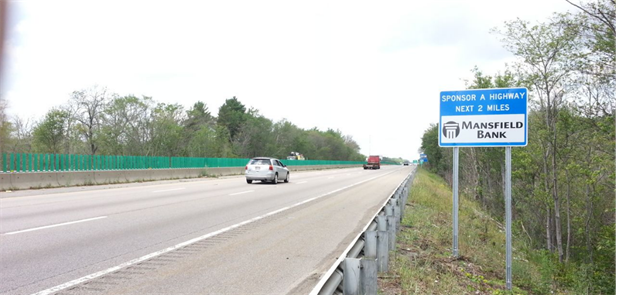
Source: Keep Massachusetts Beautiful (https://keepmassbeautiful.org/what-we-do/litter-prevention-cleanup/sponsor-a-highway-program.html)
Many states operate highway sponsorship programs solely for litter removal (e.g., Minnesota DOT's Adopt-a-Highway program6) or landscaping maintenance such as mowing and pruning (e.g., Sponsor a Highway). But some agencies are taking an innovative approach to highway sponsorships that encompasses a wider variety of services along the right-of-way, ranging from landscaping and beautification to placemaking and historic interpretation. These programs do not necessarily result in additional revenue. Instead, they may offset the cost of routine trash collection or maintenance or generate value for the community in nonmonetary ways. Innovative highway sponsorship programs provide a wider range of public benefits, such as CO2 absorption,7 pollinator and native species protection, and even safety improvements.8
The Minnesota Highway Sponsorship program, enabled by the State legislature in 2017, was designed with a broad scope. The statute enables the State DOT to "enter into volunteer agreements with businesses, civic groups or individuals to support, maintain and make improvements to real property included in the trunk highway system." The legislation established a special fund to collect sponsorship revenue and prohibits program activities that result in the loss or return of Federal highway funds.
Figure 2. Minnesota Sponsorship Program – Range of Project Types
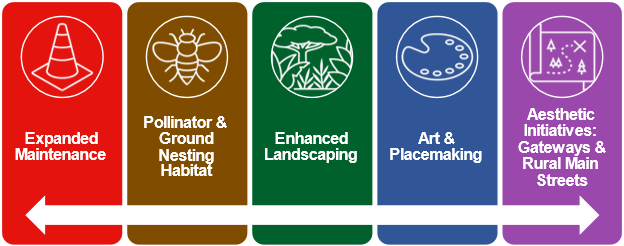
Source: Inspired by a MNDOT infographic about the Minnesota Highway Sponsorship Program.
Under the program's first sponsorship license, Andersen Corporation provided screening mitigation and landscaping services along a stretch of Highway 95 in front of the company's Bayport industrial facility. The City of Bayport, motivated by the desire to preserve the city's scenic views, initiated the project. Under the sponsor license, Andersen assumed the cost of the design, planting, and installation of roadside landscaping and pays its own employees for ongoing maintenance. In this case, the sponsor benefited from access to the publicly owned right of way so that it could enhance the landscaping in front of its property, in addition to the positive marketing from the acknowledgement of its sponsorship. For more details, see the case study.
MnDOT's program was inspired in part by the Chicago Gateway Green Expressway Partnership Program. The Chicago Gateway Green is a nonprofit organization that works with the City of Chicago and the Illinois DOT to facilitate the sponsorship of roadside gardens by local businesses and community organizations. With costs underwritten by the sponsoring entity, the organization hires professional landscaping crews to design and maintain each sponsored garden. As of 2021, the program included over 100 gardens on 150 acres. Sponsoring entities include small local restaurants and radio stations and several Chicago sports teams.9 Crews have also removed over 1.5 million tons of litter from Chicago roadsides.
Figure 3. Chicago Gateway Green Garden Sponsorship Acknowledgment Sign
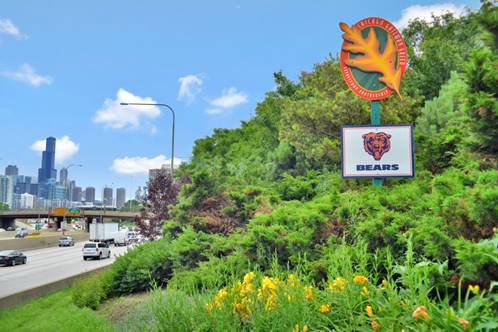
Source: Chicago Gateway Green Expressway Partnership https://www.gatewaygreen.org/expressway-partnership/
Sponsorship of highway safety patrol vehicles and highway rest stops, service plazas, and welcome centers is growing in popularity. From the agency perspective, these programs have low barriers to entry – meaning that they do not require a significant capital outlay or specialized expertise to start or operate. Furthermore, they can generate revenue for the transportation agency on an ongoing basis. From the sponsor's point of view, these agreements provide opportunities to generate a positive reputation for the sponsoring company in areas where billboards and advertising are prohibited. Sponsorship contributions may also be tax deductible.10 These two types of sponsorship programs are discussed in greater detail below.
Twenty-two state agencies have highway safety patrol vehicle sponsorship agreements. To promote safety and reduce congestion delays, State DOTs have large service-vehicle fleets for clearing crashes and assisting stranded vehicles. Safety patrols typically operate in urban areas with significant traffic volume, because this is where the majority of crashes occur. As a result, the service vehicles operate where they are visible to a large number of motorists.
This visibility is of value to some private companies – primarily auto insurance providers – that are willing to sponsor the service, in exchange for company branding on fleet vehicles, roadside signs, and acknowledgment on informational brochures and in social media posts. Two examples of this type of sponsorship are the Massachusetts Highway Assistance Program sponsored by MAPFRE Insurance and Ohio DOT State Farm Safety Patrol.
The Massachusetts Highway Assistance Program was the first safety patrol in the U.S. to enter a sponsorship agreement with a private company, and it is the longest-running sponsorship program in the country. The current sponsor, MAPFRE Insurance, was first selected in 2003 through an open, competitive bidding process and has re-secured the contract periodically over the past 18 years. The sponsorship was extended by one year in 2017. In 2018 MAPFRE was again selected as the sponsor through an open, competitive bidding process. Under the current 3-year agreement, MAPFRE sponsors 45 vehicles, including service vans and flatbed tow trucks, that patrol the Commonwealth's most heavily traveled roadways.
Figure 4. Massachusetts Highway Assistance Patrol Truck with Sponsorship Acknowledgment
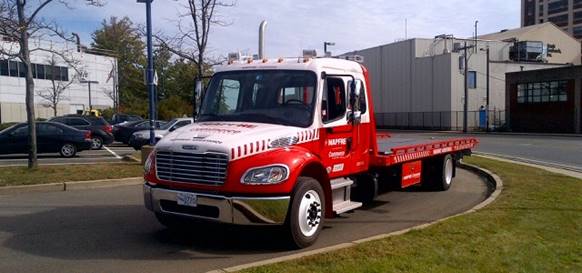
Source: MassDOT Blog, October 2013. https://blog.mass.gov/transportation/massdot-highway/new-highway-assistance-patrol-vehicles-unveiled/Estimating the Marketing Value of Your Assets
Facing budget constraints, the Ohio Department of Transportation (ODOT) entered into a sponsorship agreement with State Farm Insurance in 2014. The agreement was originally facilitated by intermediaries that specialize in public-private partnerships for marketing, including Travelers Marketing, but is now administered directly by ODOT. Through this agreement, State Farm advertises on ODOT vans that patrol highways to assist motorists. This agreement will raise as much as $8.65 million over 10 years, which helps to offset part of the program operation costs. This case study provides additional details regarding program operation and benefits.
Though rest stops, service plazas, and welcome centers along highways built and maintained with Federal dollars cannot enter naming rights agreements, they can have sponsorship agreements. The Safe Phone Zones program, administered by Travelers Marketing, is one example of this type of agreement.11 The first Safe Phone Zone was established in 2012 by agreement between GEICO and Virginia DOT. Safe Phone Zones are now in nine states, eight sponsored by GEICO, and one sponsored by Encova Insurance.
State DOTs and auto insurance companies have a shared interest in reducing texting while driving, which is a leading cause of distracted driving-related crashes. At the same time, budgetary constraints have led many DOTs to reduce the number of rest areas where drivers can pull over to text safely. By "branding" rest stops as Safe Phone Zones, participating state DOTs and GEICO hope to reduce distracted driving-related crashes. The sponsor provides the DOT with revenue to support continued operation of the rest area, and in exchange, the sponsor receives acknowledgment in high-visibility locations. In May 2018, North Carolina designated all 58 State-owned rest stops Safe Phone Zones. GEICO pays the agency $225,000 annually for an initial contract term of 2 years.12 This revenue is used to offset the costs of maintaining the rest areas.
Figure 5. NCDOT and FHWA Employees with a Safe Phone Zone Roadside Sign
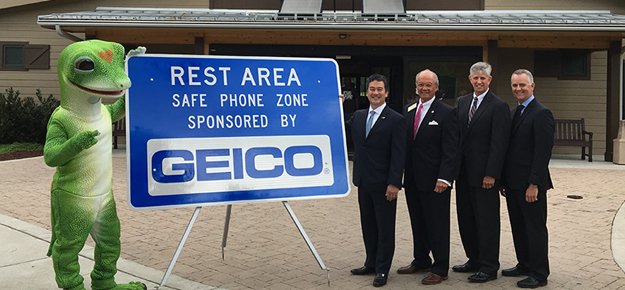
Source: Travelers Marketing, Safe Phone Zones. Accessed August 2021 http://safephonezone.com/northcarolina/index.html
Two aspects that the techniques described above have in common is the need to identify and form partnerships with sponsors and the need to determine the value of the program to potential sponsors. These inter-related issues are discussed below.
Traveler volume information can be an essential tool in determining the potential value of a naming rights agreement or sponsorship of a physical asset. A central-urban transit center that has tens of thousands of visitors every day will be more attractive to sponsors than smaller, suburban locations, and thus can support a larger price tag. The travel data may exist for some assets, such as transit stations that collect fares. Agencies typically do not have accurate data on average annual daily traffic for all road segments in their network, but the data can be collected using automated traffic counters or can be purchased from a company that uses GPS or cellular information to estimate volumes
When determining an appropriate price for naming rights or sponsorship, the cost of replacing signage to reflect the new name must be factored in and compliance of the new signage with relevant Federal, State, and local regulations, including the Americans with Disabilities Act, must be ensured.
As noted in the FHWA value capture manual, and throughout the Value Capture Toolkit, all value capture is delivered through some level of partnership between the public and private sectors. For some value capture techniques, such as negotiated exaction and impact fees, the partnership is implied, and no contract or explicit agreement exists between the implementing agency and private sector entities or beneficiaries. Other techniques, such as special assessment districts, business improvement districts, or sales tax districts, achieve partnership through an official vote (either of property owners, in the case of the two former, or all voters in a jurisdiction in the case of the latter). What ties together the particular set of tools discussed here is that they are all delivered through active, contract-based, public-private partnerships. Developing these partnerships requires identifying, recruiting, and working with sponsors.
Most states have broad legislative authorization allowing public agencies to form public-private partnerships relating to transportation assets. Depending on the asset that an agency is seeking sponsorship for, the agency may choose to issue a request for proposals that seeks a sponsorship agreement for the asset. This is the approach used by the Massachusetts Highway Assistance Program. In addition to recruiting potential sponsors, a competitive bidding process helps in determining the market value of the agreement.
Alternatively, some agencies engage a consulting agency specializing in negotiating sponsorship agreements for public assets. ODOT used this approach in establishing its highway safety patrol vehicle sponsorship program and identifying State Farm as a sponsor. VDOT and NCDOT also used this approach, engaging the Safe Phone Zones program to identify and recruit sponsors for rest stop facilities.
Several companies have established programs for sponsorship of public assets. State Farm runs its Assist Patrol program, which sponsors highway safety patrol fleets in 19 states.13 To determine the value of sponsorship, State Farm works with Travelers Marketing, a consulting firm that specializes in advertising agreements for transportation assets. Travelers Marketing also administers the Safe Phone Zones program.14 These established sponsorship programs use defined equations to calculate the appropriate value of a sponsorship based on the estimated number of impressions (the number of views of or engagements with acknowledgments) they are expected to generate for the sponsoring entity.
As this brief illustrates, capturing the marketing value of transportation assets can be done simply, such as through an Adopt-a-Highway or Highway Sponsorship program, or it can be done more intensively through a custom-designed program. Such programs may be based on short-term agreements or may involve forming long-term partnerships. Some techniques provide revenue for transportation operations and infrastructure, while others simply offset (or partially offset) the cost of the asset or service being sponsored. Some techniques do not generate revenue, but instead promote nonmonetary public benefits such as improved safety, visual aesthetics, or environmental benefits such as native plantings, pollinator habitats, and CO2 reduction.
Value capture techniques that leverage the marketing value of public assets present a low barrier to entry for public agencies, so agencies do not need to acquire expensive equipment, develop specialized expertise, or maintain a dedicated staff to implement them. They also involve little risk to the agency, because in most cases, the asset would exist or service would be provided whether sponsored or not.
| Topic | Source | Where to Find |
|---|---|---|
| Public-Private Partnerships for Transportation: A Toolkit for Legislators | National Conference of State Legislatures | https://rosap.ntl.bts.gov/view/dot/18441 |
| HWA Order 5160.1A: Policy on Sponsorship Acknowledgment and Agreements within the Highway Right-of-Way | Federal Highway Administration | https://www.fhwa.dot.gov/legsregs/directives/orders/51601a.cfm |
| Naming Rights: Fact Sheet | Federal Highway Administration: Center for Innovative Finance Support | https://www.fhwa.dot.gov/ipd/fact_sheets/value_cap_naming_rights.aspx |
| Minnesota Highway Sponsorship Program Fact Sheet | Minnesota DOT | http://www.dot.state.mn.us/publicengagement/documents/workshop/2019-materials/highway-sponsorship-program-fact-sheet.pdf |
1 "Marketing vs. Advertising," American Marketing Association (https://www.ama.org/pages/marketing-vs-advertising/).
2 "Marketing vs. Advertising," American Marketing Association.
3 FHWA Order 5160.1A Policy on Sponsorship Acknowledgment and Agreements within the Highway Right-of-Way (https://www.fhwa.dot.gov/legsregs/directives/orders/51601a.cfm)
4 The use of naming rights at rest stops along Federally funded highways was previously allowed and still exists in locations where naming rights agreements were in place before the legislation prohibiting the practice.
5 FHWA Order 5160.1A Policy on Sponsorship Acknowledgment and Agreements within the Highway Right-of-Way (https://www.fhwa.dot.gov/legsregs/directives/orders/51601a.cfm ).
6 Minnesota Department of Transportation. Adopt-A-Highway Program. https://www.dot.state.mn.us/adopt/
7 Content no longer available online.
8 National Association of City Transportation Officials. Comparison of Safety Performance of Urban Streets Before and After Landscape Improvements. April 30, 2003. https://nacto.org/wp-content/uploads/comparison_of_safety_performance_of_urban_streets_after_landscape_improvements_mok.pdf
9 Chicago Gateway Green. Accessed August 2021. https://www.gatewaygreen.org/partners/
10 See New York City Adopt-A-Highway Program (https://www1.nyc.gov/html/dot/html/infrastructure/adopthwy.shtml )
11 Travelers Marketing, Safe Phone Zones. Accessed September 2021 (http://safephonezone.com/press.html).
12 Citizen Times. "Answer Man: NCDOT rest areas paid for by Geico?" April 18, 2019. https://www.citizen-times.com/story/news/local/2019/04/18/answer-man-geico-pays-ncdot-rest-areas/3483691002/
13 State Farm Assist Patrol. Accessed August 2021. https://newsroom.statefarm.com/safety-patrols-help-1-million-motorists/
14 Travelers Marketing, Safe Phone Zones